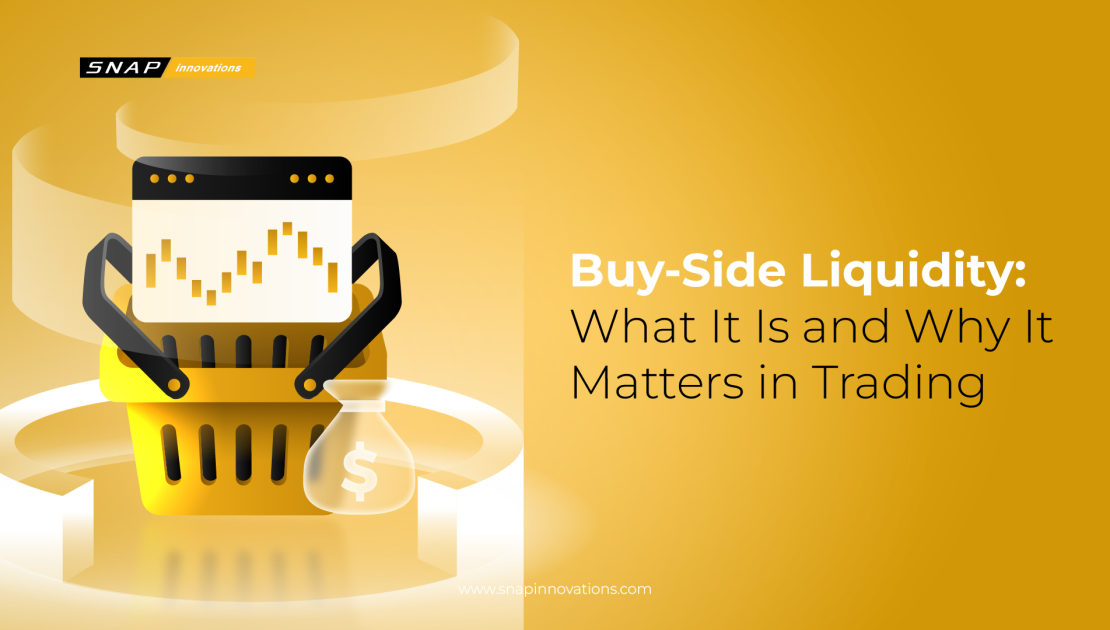In the intricate ecosystem of global financial markets, liquidity serves as the lifeblood that enables seamless trading and efficient price discovery. While most traders and investors are familiar with the concept of liquidity, fewer understand its bifurcation into buy-side and sell-side liquidity—two forces that collectively shape market behavior. Among these, buy-side liquidity is particularly pivotal, as it reflects the latent demand from institutional investors and funds that drive long-term market trends.
The dynamics of buy-side liquidity are not merely academic; they play a tangible role in price stability, trading volumes, and even the broader health of financial systems. Institutional capital—like that of hedge funds, mutual funds, pension funds, and insurance companies—represents vast pools of capital that have the potential to shift markets. Understanding what buy-side liquidity means, and how it operates, is crucial for traders, portfolio managers, and even retail investors trying to navigate modern financial markets.
What is Buy-Side Liquidity?
 Buy-side liquidity refers to the availability of institutional capital that is ready to be deployed into financial markets to purchase securities such as stocks, bonds, commodities, or derivatives. This contrasts with sell-side liquidity, which relates to the ability and willingness of market makers and dealers (often banks and brokerage firms) to provide assets for sale. In essence, buy-side liquidity reflects the demand side of the market equation.
Buy-side liquidity refers to the availability of institutional capital that is ready to be deployed into financial markets to purchase securities such as stocks, bonds, commodities, or derivatives. This contrasts with sell-side liquidity, which relates to the ability and willingness of market makers and dealers (often banks and brokerage firms) to provide assets for sale. In essence, buy-side liquidity reflects the demand side of the market equation.
Buy-side institutions—such as pension funds, mutual funds, insurance companies, and hedge funds—are primarily asset allocators. They manage large sums of money on behalf of clients or stakeholders and are constantly evaluating the right time and price to enter the market. When these players are active and looking to buy, markets tend to experience increased upward momentum and improved liquidity. Conversely, when buy-side participants retreat or go risk-off, markets can dry up, leading to reduced trading activity and more volatile price action.
Read More: Best Coding Languages for Trading Algorithms
Why Buy-Side Liquidity Matters
Buy-side liquidity plays a pivotal role in setting the tone for market sentiment and long-term asset valuations.
The importance of buy-side liquidity extends far beyond the volume of assets transacted on any given day. It is a barometer of confidence in the economy and market direction. When institutional buyers step into the market, their sheer volume of orders can stabilize prices, absorb volatility, and create bullish trends that attract retail investors and momentum traders. It is not uncommon for a surge in buy-side demand to lead to breakout rallies or bullish reversals, especially when supported by macroeconomic catalysts.
Conversely, a lack of buy-side liquidity can be just as telling. If institutions are unwilling to deploy capital, it may indicate uncertainty, overvaluation, or systemic risk concerns. In such scenarios, even positive news may fail to move markets significantly, as the buy-side “firepower” necessary to generate a sustained rally is absent. Therefore, monitoring the state of buy-side liquidity is not just a matter of interest for large funds—it’s essential for anyone trying to understand where markets are headed.
Key Components That Influence Buy-Side Liquidity
 Understanding the components that affect buy-side liquidity helps investors predict when institutional capital may flood or flee the market.
Understanding the components that affect buy-side liquidity helps investors predict when institutional capital may flood or flee the market.
Buy-side liquidity doesn’t exist in a vacuum. It’s shaped by a variety of internal and external factors that determine whether institutional investors are willing to put capital at risk. Here are some of the main influences:
1. Macroeconomic Indicators
Economic conditions have a direct impact on institutional behavior. Factors such as interest rates, inflation, GDP growth, and employment data can all sway buy-side sentiment. For instance, rising interest rates may make fixed-income instruments more attractive than equities, reducing buy-side liquidity in the stock market.
When central banks like the Federal Reserve implement dovish policies, they effectively make borrowing cheaper, encouraging institutional investors to leverage up and increase exposure to risk assets. Conversely, hawkish policies may prompt funds to reduce equity exposure, shrinking buy-side liquidity.
2. Risk Appetite and Market Sentiment
The overall risk appetite of institutional investors also determines how much capital they are willing to allocate to different asset classes. During periods of uncertainty or market turbulence—like geopolitical conflicts or pandemics—buy-side liquidity can evaporate as funds move into safer investments like gold or government bonds.
Sentiment can be gauged through tools like the Volatility Index (VIX), credit spreads, or institutional investor surveys. High fear levels often correspond with reduced buy-side participation, while bullish sentiment drives liquidity back into markets.
How Buy-Side Liquidity Affects Trading and Pricing
 Buy-side liquidity doesn’t just shape market sentiment—it directly impacts how easily and fairly assets can be priced and traded.
Buy-side liquidity doesn’t just shape market sentiment—it directly impacts how easily and fairly assets can be priced and traded.
When buy-side liquidity is abundant, bid-ask spreads narrow, slippage is reduced, and large trades can be executed without significantly moving the market. This is because there is enough demand to absorb sell orders at or near current market prices. Such conditions are ideal for both institutional and retail traders, as they ensure smoother transactions and less price volatility.
On the flip side, a lack of buy-side liquidity can create a scenario where even moderately sized sell orders cause disproportionate price drops. This is often seen during market panics or sell-offs, where the absence of willing institutional buyers leads to liquidity vacuums. Here are some of the key implications:
- Price Dislocations: Assets may temporarily trade at levels far below their intrinsic value due to a lack of demand.
- Market Inefficiencies: Arbitrage opportunities may increase, but so does risk, making it harder for traders to capitalize.
- Higher Transaction Costs: Wider spreads and more slippage can lead to increased trading costs, particularly for large orders.
Comparing Buy-Side vs. Sell-Side Liquidity
While both buy-side and sell-side liquidity are critical for a functioning market, they operate on fundamentally different principles.
| Feature | Buy-Side Liquidity | Sell-Side Liquidity |
| Role in Market | Represents demand to purchase assets | Represents supply to sell assets |
| Main Participants | Hedge funds, mutual funds, pension funds, insurers | Investment banks, brokers, dealers, market makers |
| Capital Source | Investor funds and client assets | Proprietary capital or client facilitation |
| Trading Behavior | Often long-term, based on fundamental analysis | Short-term, focused on market-making and arbitrage |
| Market Impact | Can initiate price rallies and support market stability | Provides necessary counterparties for trades |
| Liquidity Conditions | Increases in bull markets, dries up in crises | Relatively consistent but narrows during high volatility |
Buy-side liquidity is less consistent than sell-side liquidity because it is influenced by sentiment, strategy, and macro conditions. Sell-side players have a market-making mandate and are often obliged to provide liquidity regardless of market direction. That said, both sides must exist in balance for a market to function properly.
Trends in Buy-Side Liquidity During Key Economic Events
Below is a downloadable chart that illustrates fluctuations in buy-side liquidity during major economic events from 2008 to 2023, such as the Global Financial Crisis, COVID-19 crash, and periods of quantitative easing. The data highlights how institutional buying activity surged or dwindled in reaction to macro conditions.
Explanation:
The chart shows that buy-side liquidity plunged during the 2008 financial crisis and again in March 2020 during the onset of the COVID-19 pandemic. In both cases, central bank intervention—especially in the form of QE—helped restore confidence, bringing institutional buyers back into the fold. On the other hand, liquidity soared during bullish periods like 2017-2018 when macro indicators were stable, and risk appetite was high.
This cyclical nature of buy-side liquidity underscores its sensitivity to economic signals, highlighting the need for investors to track not just prices, but also participation levels.
Buy-Side Liquidity in Different Asset Classes
Not all markets experience buy-side liquidity in the same way; asset classes vary based on structure, risk, and institutional interest.
1. Equities
Equity markets are the most visibly impacted by buy-side liquidity. Large mutual funds, pension funds, and hedge funds significantly influence price movements when they enter or exit positions. In periods of high buy-side activity, you often see bull runs and increased trading volumes.
Additionally, index funds and ETFs have amplified the importance of buy-side flows, as passive investment strategies now account for a significant portion of the equity market. When capital flows into these funds, it indirectly increases demand for underlying stocks, boosting liquidity.
2. Fixed Income and Bonds
Bond markets, especially those involving government securities, have different dynamics. Liquidity here can be more fragmented, but buy-side players like sovereign wealth funds, insurers, and pension funds are primary drivers of demand. Changes in interest rate outlooks heavily influence their activity.
The corporate bond market, in particular, is vulnerable to buy-side pullbacks during stress periods, as seen in March 2020 when the Fed had to intervene directly to support liquidity.
Indicators to Measure Buy-Side Liquidity
To assess buy-side liquidity, analysts often rely on a combination of quantitative and qualitative indicators that reveal institutional participation trends. These metrics help identify shifts in demand, emerging market sentiment, and the overall willingness of institutions to allocate capital. By closely monitoring these indicators, investors can anticipate changes in liquidity conditions and adjust their strategies accordingly.
These indicators not only provide insights into current market dynamics but also offer predictive power. Patterns in fund flows, position data, and breadth statistics often precede major market movements. This makes them valuable tools for both short-term trading decisions and long-term investment planning.
1. Fund Flows
Tracking inflows and outflows from mutual funds, ETFs, and pension funds provides a real-time pulse on where institutional money is moving. Large inflows often precede rallies, while outflows can signal impending market corrections. These data are typically released on a weekly basis and segmented by asset class, geography, and sector.
Persistent positive fund flows suggest that institutions are confident in future market performance, indicating healthy buy-side liquidity. Conversely, significant or sudden outflows may reflect deteriorating sentiment or a shift toward risk aversion, which can result in reduced market liquidity and increased volatility.
2. Commitment of Traders Reports (COT)
Published weekly by the Commodity Futures Trading Commission (CFTC), the COT report outlines the positions of institutional traders in futures markets. A surge in long positions often indicates growing buy-side confidence and liquidity, whereas a buildup of short positions may reflect hedging activity or bearish expectations.
The report distinguishes between different types of market participants—commercial, non-commercial, and retail traders. Analysts particularly focus on non-commercial traders, such as hedge funds and large asset managers, whose positioning provides a window into the sentiment of professional market participants. Tracking changes in their exposure over time can reveal emerging trends in buy-side behavior.
3. Market Breadth Indicators
These include metrics like the number of advancing vs. declining stocks, the ratio of new highs to new lows, and cumulative volume indicators. Strong market breadth generally suggests that institutional buying is widespread, extending across various sectors and market capitalizations.
Weak or narrowing breadth, where only a few large-cap stocks are driving index gains, can be a warning sign. It may indicate that buy-side liquidity is concentrated rather than broad-based, making the market more susceptible to corrections. Breadth indicators are especially useful during rally phases, where confirmation from multiple sectors is crucial to sustain momentum.
Read More: 10 Online Trading Platforms in 2024
Conclusion
Buy-side liquidity is a critical yet often underappreciated force in financial markets. It reflects the demand side of the trading equation, driven by institutions that allocate capital based on long-term strategies, macroeconomic outlooks, and market sentiment. Unlike the more continuous nature of sell-side liquidity, buy-side participation can be volatile—flooding into markets during bull phases and vanishing during periods of uncertainty.
Understanding the behavior and triggers of buy-side liquidity provides invaluable insights for traders and investors at all levels. Whether you’re interpreting market trends, planning entry points, or managing portfolio risk, the presence—or absence—of buy-side activity can be the difference between success and failure. In today’s interconnected markets, tracking institutional flows has become not just an advantage—but a necessity.

